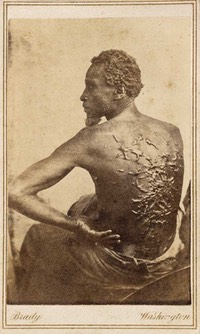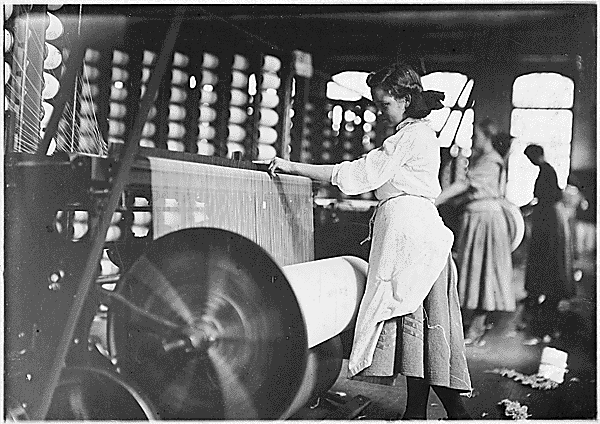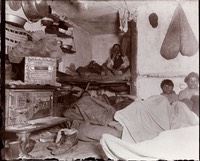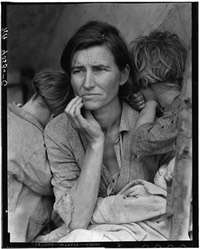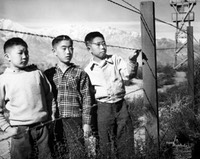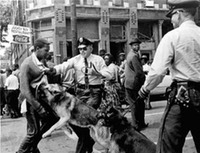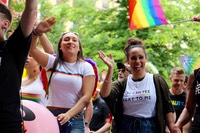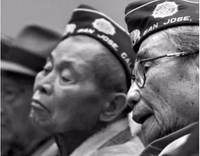
“A picture is worth a thousand words,” as the saying goes. It is so true, especially for social studies teachers. A single image can be a powerful way to introduce a lesson, serving as a doorway into a historical event. Photo analysis can aid in student writing. And through studying photographs students can to learn empathy for others, even take steps toward civic engagement.
Photo Analysis
For example, during my unit on the Civil War I use the famous photograph of an escaped slave,“Private Gordon", to begin the discussion of the role of African American soldiers in the Union Army. The Private Gordon Lesson starts with me showing the photo to my class and asking four simple questions: What is the most powerful part of this photograph? How do you think Private Gordon got the scars on his back? How does the photograph make you feel? Why might someone take this photograph? After the discussion students read an online article, "Photography Changes the Way We Record and Respond to Social Issue", by Frank H. Goodyear, III. This piece adds historical background to the photo, including: Gordon’s escape from slavery, his enlistment in the Union Army, and the role this photo and photography played in bolstering the Abolitionist cause during the Civil War. Think about the next unit you are teaching, is there a single photo that might be a doorway into your lesson?
Once you’ve modeled photo analysis with your whole class, work on helping students make photo inferences and predictions on their own. You might want to use Lewis Hine’s photographs, poignant images of child labor at the turn of the 20th century. The National Archives’ Educational Resources page has good tips for analyzing photographs, beginning with close observations of photo details, including people, objects and activities.
Typically, I model whole class, analyzing one photo with my students. Then I have students work with a classmate. In the case of the child labor photos, I give each pair of students a printed version of a different Hine photograph. Students use my Lewis Hine Child Labor Lesson handout to jot down details about their photo with their partner, making inferences and asking further questions. When students complete their work, I show each of the child labor photos to the whole class. As their photo is projected, two students share their observations and questions with classmates. Finally, all students read the National Archives webpage, Lewis Hine: Documentation of Child Labor, answering my questions on the back of the Lewis Hine Child Labor Lesson handout. Hine’s photos provoke interest in child labor, while the article helps answer questions generated by my students in the first part of the lesson.
Like any new skill, photo analysis requires students to practice before gaining mastery. For this reason, during the Progressive Era unit I give students a second photo analysis assignment, this time with a Jacob Riis’ photograph "Five Cents a Spot". In the Five Cents a Spot Lesson students dissect a photo which revealed New York City’s crowded tenements and poor living conditions. In addition, they read more about Riis in Bonnie Yochelson's article, "Photography Changes Our Awareness of Poverty”.
Photographers: Catalysts for Change
Photographers have been catalysts for change. Lewis Hine’s photos exposed child labor, influencing Congress to pass child labor laws. Jacob Riis' writing and images spurred city planners to improve the living conditions in New York neighborhoods. Perhaps no 20th century photographer has had a greater impact on defining a historical era than Dorothea Lange with her iconic photos of the Great Depression.
I use Lange’s photos with all my US History students, but her work has been particularly important for my English Learners. Before they hear from me, read or take notes about the 1930’s, I introduce The Great Depression to these students by showing them a succession of some of Lange's most powerful images in a slideshow. Students can see for themselves the worried look on the face of a migrant mother, the shoeless children in the shanty towns, and the poor huddled in breadlines. These photos provide a window into the desperation of Americans during the Great Depression that no other type of lesson can match. Students also learn more about Lange’s work from a short PBS video segment, "The Great Depression: Creating A Narrative Through Photography".
Photos and Student Writing
I have found that photos can encourage strong student writing. While studying Japanese American Internment during World War II, my students are asked to write a letter back home, describing their experiences. Students begin by gathering details from a series of photos of the Manzanar internment camp. Four leading photographers - Ansel Adams, Clem Albers, Dorthea Lange, and Toyo Miyatake documented the conditions in Manzanar. The Letter from Manzanar Lesson not only asks students to describe life in the camps, but also to share the feelings that a Japanese American teenager might have during his or her incarceration. This assignment is designed to help students gain empathy for those behind the barbed wire, under the harsh gaze of guard towers.
Empathy and Civic Engagement
Photo assignments, like the letter home from Manzanar, provide opportunities for students "to walk a mile in someone's shoes.” They can also show our students the power of protest and youth civic engagement. The photo and letter writing lesson, Write Your Letter from the Birmingham Jail, is designed to do just that. It focuses on the 1963 Children’s Crusade, also known as the Children’s March, in Birmingham, Alabama. The Civil Rights protest was composed of African American school children the age of the students we teach. In the slideshow The Nonviolent Struggle for Civil Rights, students analyze five photos taken by photographer Charles Moore. This Civil Rights photographer captured black students facing police dogs, water hoses, and arrest for their non-violent protest. In addition to gathering details from these photos, students also watch the award-winning student documentary, No More: The Children of Birmingham 1963 and the Turning Point of the Civil Rights Movement, made by Miranda and Mckay Jessop for the 2013 History Fair. Once students have gathered details, it is time to write.
The assignment, Write Your Letter from the Birmingham Jail, asks students to imagine that they were a teenager in the Children’s Crusade. The prompt says, “You have been arrested. As you sit in your cell write a letter to a friend who did not participate. Use the details from the notes you took explaining why you chose to participate in the march, what happened on the march and how you feel waiting in your jail cell.”
The Vietnam War - Photos that Changed Public Opinion

The Vietnam War was the first American conflict shown on nightly television. Along with news reports, photographers took a series of powerful images which had a significant impact on public opinion. Have students view and analyze these historical photos from the Vietnam War, including the attack on the US embassy by the Vietnamese communists (1968), the My Lai Massacre (1968), and the Anti-War protester shot at Kent State (1970). Each photo is an opportunity to teach more details of the war, and also a chance for students to experience the events which fractured US citizens into hawks and doves. These photographs can be a catalyst for a larger discussion, too : when should a nation go to war?
Find A Photo
Photographs can also be a bridge between historical themes in your course and current events. A simple lesson I designed is called Find A Photo. Here I ask students to find a contemporary photograph, illustrating a historical theme we are studying. For example, students may find and analyze a photo of child labor somewhere in the world today. Or I may ask students to bring in a photo that demonstrates the power of protest. Their job is to find a photo, write an analysis of the image, and share it with classmates.
We have seen so far that photo analysis can be effectively used in a history class, especially in conjunction with non-fiction texts, video, and writing assignments. In addition, photo analysis is useful in teaching Economics and US Government, too. For example, I asked my senior economics students to find and write about a photo that illustrated one of the three main economic systems. In US Government class students were assigned to find a photo highlighting a current controversy in the fight for equality and democratic rights, such as the debate over LGBT rights. Here again, students were to write about their choice and share it with the class.
Choose the Best Image
I designed several assignments, asking students to critically think about the best image to represent an event or movement. For example, in the lesson, Choose a Book Cover Image for the Civil Rights Movement, students worked with a partner, analyzing four iconic Civil Rights photos. My prompt asked, "Imagine you were designing a book cover on the Civil Rights Movement. Your job includes choosing the best image for the cover. Look at the four images below. Discuss each image with your partner, jotting down the strengths of each image, but also its limitations. Be prepared to explain to the class your final pick. Which would make the best image for the cover?”
Students had to make similar image choices in my lesson, Fighting Filipinos of World War II. Students read background articles about the Bataan Death March and a Filipino guerrilla fighter. They watched the “Forgotten Warriors,” a documentary about Filipino veterans. Finally, students analyzed four images, each told one part of the story of the fighting Filipinos during World War II. The prompt said, imagine you are writing a chapter in a textbook, but you are only able to use one image. Think about the the positives and limitations of each image.” Of course, there are no right answers to these assignments, but they are great for getting kids to think critically about images and the historical periods they represent.
Finding Photographers
I guarantee if you do photo analysis throughout the year in your social studies classes you are going to discover that several of your students are budding photographers. When your class is working on projects, you might want to give these students a chance to showcase their talents. During the Great Recession a decade ago, I remember one young photo journalist from my class made a series of poignant photos of shuttered car dealerships in our town. Dorthea Lange would have been proud.
Photo Lessons
Photo Analysis Lesson: Private Gordon
- Private Gordon Lesson - Forrest Handout pdf
- Photo “Private Gordon"
- Goodyear, Frank. “Photography Changes the Way We Record and Respond to Social Issues.” Archive.li, Smithsonian Photography Intiative, 1 May 2013, archive.li/36gO3.
Photo Analysis Lesson: Lewis Hine Photos of Child Labor
- Lewis Hine Child Labor Lesson - Forrest Handout pdf
- “Teaching with Documents: Photographs of Lewis Hine: Documentation of Child Labor.” National Archives and Records Administration, National Archives and Records Administration, 14 Feb. 2017, www.archives.gov/education/lessons/hine-photos.
- “Analyze a Photograph.” National Archives and Records Administration, National Archives and Records Administration, 7 Mar. 2017, www.archives.gov/education/lessons/worksheets/photo.html.
Photo Analysis Lesson: Jacob Riis’ Five Cents a Spot
- Five Cents A Spot Lesson - Forrest Handout pdf
- Riis, Jacob. “Five Cents A Spot.” Library of Congress, www.loc.gov/exhibits/jacob-riis/images/jr0061_enlarge.jpg.
- Yochelson, “Photography Changes Our Awareness of Poverty” click! (Smithsonian Photography Initiative. July 14, 2014.
- Jacob Riis: Revealing How the Other Half Lives 14 Apr. 2016, www.loc.gov/exhibits/jacob-riis/images/Riis_Brochure.pdf.
Dorothea Lange Photographs of Great Depression: Migrant Mother
- The Great Depression Slideshow - Photos by Dorothea Lange - Forrest ppt.
- Lange, and Dorothea. “Destitute Pea Pickers in California. Mother of Seven Children. Age Thirty-Two. Nipomo, California.” The Library of Congress, 1 Jan. 1970, loc.gov/pictures/resource/fsa.8b29516/.
- “Farm Security Administration/Office of War Information Black-and-White Negatives – About This Collection.” Apple Computers: This Month in Business History (Business Reference Services, Library of Congress), Victor, 1 Jan. 1970, www.loc.gov/pictures/collection/fsa/.
- “The Great Depression: Creating Narrative through Photography.” PBS Learning Media, ca.pbslearningmedia.org/resource/lang14.soc.ushist.docphot/documenting-the-great-depression-creating-narrative-through-photography/.
A Letter from Manzanar- Japanese American Internment Lesson
- Photos of Manzanar Internment Camp - Forrest Slide Show ppt
- Gathering Details from Photographs - Forrest Handout pdf
- A Letter from Manzanar Assignment - Forrest Handout pdf
- Miller, Bettye. “Memories of Manzanar.” UCR Today, ucrtoday.ucr.edu/27698.
Write Your Letter from the Birmingham Jail
- Write Your Letter from the Birmingham Jail - Forrest Handout pdf
- The Nonviolent Struggle for Civil Rights, Forrest Slideshow ppt
- O'Neill, Claire. “Charles Moore, Photographer of The Civil Rights Movement, Dies At 79.” NPR, NPR, 16 Mar. 2010, www.npr.org/sections/pictureshow/2010/03/charles_moore.html.
Photographs that Changed US Opinion about the Vietnam War
Photographs that Changed US Opinion About the Vietnam War - Forrest Handout pdf
Are you a Hawk or Dove? Forrest Handout pdf
Thinking About War- Forrest Handout pdf
Find A Photo
- Find a Photo: Child Labor Today - Forrest Handout pdf
- Find a Photo: Economic Systems - Forrest Handout pdf
- Find a Photo: Template - Forrest Template Word
Book Cover Image for Civil Rights
Choose a Book Cover Image for the Civil Rights Movement,- Forrest Handout pdf
The Fighting Filipinos - Photo Analysis Lesson
- Fighting Filipinos of World War II - Forrest Handout pdf
- Bataan Death March - Bataan Legacy - World War II in the Philippines, The Legacy of Two Nations - The Bataan Historical Society
- Filipino guerrilla fighter - Yang, 15 Year-Old Student Interviews a War Veteran, Inquirer.net
- Forgotten Warriors, Diroy, Dana, Video, https://vimeo.com/5935301
